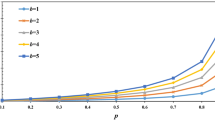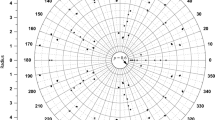Abstract
Any event that results in sudden change of the normal functioning of a system may be thought of as a catastrophe. Stochastic processes involving catastrophes have very rich application in modeling of a dynamic population in areas of ecology, marketing, queueing theory, etc. When the size of the population reduces abruptly as a whole, due to a catastrophe, it is termed as the total catastrophe. However, in many real-life circumstances the catastrophes have a mild influence on the population and have a sequential effect on the individuals. This paper presents a discrete-time catastrophic model in which the catastrophes occur according to renewal process, and it eliminates each individual of the population in sequential order with probability p until the one individual survives or the entire population wipes out. The individuals arrive according to the discrete-time Markovian arrival process. Using the supplementary variable technique, we obtain the steady-state vector generating function (VGF) of the population size at various epochs. Further using the inversion method of VGF, the population size distribution is expressed in terms of the roots of the associated characteristic equation. We further give a detailed computational procedure by considering inter-catastrophe time distributions as discrete phase-type as well as arbitrary. Finally, a few numerical results in form of tables and graphs are presented. Moreover, the impact of the correlation of arrival process on the mean population size is also investigated.
Similar content being viewed by others
References
Alfa AS (2010) Queueing theory for telecommunications: discrete-time modelling of a single node system. Springer Science & Business Media
Alfa AS (2016) Applied discrete-time queues. Springer
Artalejo JR, Economou A, Lopez-Herrero MJ (2007) Evaluating growth measures in an immigration process subject to binomial and geometric catastrophes. Math Biosci Eng 4(4):573–594
Atencia I, Moreno P (2004) The discrete-time Geo/Geo/1 queue with negative customers and disasters. Comput Oper Res 31(9):1537–1548
Barbhuiya FP, Kumar N, Gupta UC (2019) Batch renewal arrival process subject to geometric catastrophes. Methodol Comput Appl Probab 21(1):69–83
Baumann H, Sandmann W (2012) Steady-state analysis of level dependent quasi-birth-and-death processes with catastrophes. Comput Oper Res 39(2):413–423
Blondia C (1993) A discrete-time batch Markovian arrival process as B-ISDN traffic model. Belgian J Oper Res Statist Comput Sci 32:3–23
Boudali O, Economou A (2012) Optimal and equilibrium balking strategies in the single server Markovian queue with catastrophes. Eur J Oper Res 218(3):708–715
Brockwell PJ, Gani J, Resnick SI (1982) Birth, immigration and catastrophe processes. Adv Appl Prob 14(4):709–731
Bruneel H, Kim BG (1993) Discrete-time models for communication systems including ATM. Kluwer Acadmic, Boston
Bruneel H, Wittevrongel S, Claeys D, Walraevens J (2016) Discrete-time queues with variable service capacity: a basic model and its analysis. Ann Oper Res 239(2):359–380
Chaudhry ML, Gupta UC (2003) Analysis of a finite-buffer bulk-service queue with discrete-Markovian arrival process: D − MAP/Ga, b/1/N. Naval Res Logist 50(4):345–363
Chaudhry ML, Singh G, Gupta UC (2013) A simple and complete computational analysis of MAP/R/1 queue using roots. Methodol Comput Appl Probab 15(3):563–582
Chen A, Renshaw E (1997) The M/M/1 queue with mass exodus and mass arrivals when empty. J Appl Prob 34(1):192–207
Chen A, Zhang H, Liu K, Rennolls K (2004) Birth-death processes with disaster and instantaneous resurrection. Adv Appl Prob 36(1):267–292
Claeys D, Steyaert B, Walraevens J, Laevens K, Bruneel H (2013) Analysis of a versatile batch-service queueing model with correlation in the arrival process. Perform Eval 70(4):300–316
Daniëls T, Blondia C (1998) A discrete-time ATM traffic model with long range dependence characteristics, Springer US, Boston, MA, pp 97–110
De MM, Wittevrongel S, Bruneel H (2017) Analysis of discrete-time queues with general service demands and finite-support service capacities. Ann Oper Res 252 (1):3–28
Dudin AN, Klimenok VI (1996) Queueing system with passive servers. J Appl Math Stoch Anal 9(2):185–204
Economou A (2003) On the control of a compound immigration process through total catastrophes. Eur J Oper Res 147(3):522–529
Economou A (2004) The compound Poisson immigration process subject to binomial catastrophes. J Appl Prob 41(2):508–523
Economou A, Fakinos D (2003) A continuous-time Markov chain under the influence of a regulating point process and applications in stochastic models with catastrophes. Eur J Oper Res 149(3):625–640
Economou A, Gómez-Corral A (2007) The batch Markovian arrival process subject to renewal generated geometric catastrophes. Stoch Models 23(2):211–233
Gupta UC, Samanta SK, Sharma RK, Chaudhry ML (2007) Discrete-time single-server finite-buffer queues under discrete Markovian arrival process with vacations. Perform Eval 64(1):1–19
Gupta UC, Samanta SK, Goswami V (2014) Analysis of a discrete-time queue with load dependent service under discrete-time Markovian arrival process. J Korean Stat Soc 43(4):545–557
Gupta UC, Singh G, Chaudhry ML (2016) An alternative method for computing system-length distributions of BMAP/R/1 and BMAP/D/1 queues using roots. Perform Eval 95:60–79
Hunter JJ (1983) Mathematical techniques of applied probability. In: Discrete time models: techniques and applications, vol 2. Academic Press, New York
Kapodistria S, Phung-Duc T, Resing J (2016) Linear birth/immigration-death process with binomial catastrophes. Probab Eng Inform Sci 30(1):79–111
Neuts MF (1994) An interesting random walk on the non-negative integers. J Appl Prob 31(1):48–58
Nishimura S (1998) Eigenvalue expression for mean queue length of BMAP/G/1 queue. Asia-Pacific Journal of Operational Research 15(2):193
Park HM, Yang WS, Chae KC (2009) The Geo/G/1 queue with negative customers and disasters. Stoch Models 25(4):673–688
Pradhan S, Gupta UC (2017) Analysis of an infinite-buffer batch-size-dependent service queue with Markovian arrival process. Ann Oper Res, pp 1–36
Samanta SK, Gupta UC, Chaudhry ML (2009) Analysis of stationary discrete-time GI/D − MSP/1, queue with finite and infinite buffers. 4OR 7(4):337
Takagi H (1993) Queuing analysis: a foundation of performance evaluation. Discrete time systems, vol 3. North-Holland, Amsterdam
Woodward ME (1994) Communication and computer networks: modelling with discrete-time queues. Wiley-IEEE Computer Society Pr
Yi XW, Kim JD, Choi DW, Chae KC (2007) The Geo/G/1 queue with disasters and multiple working vacations. Stoch Models 23(4):537–549
Acknowledgements
The first author Nitin Kumar is thankful to Indian Institute of Technology Kharagpur, India for the financial support. The authors wish to thank the associate editor and anonymous referees for their valuable comments and suggestions which led to the paper in the current form.
Author information
Authors and Affiliations
Corresponding author
Additional information
Publisher’s Note
Springer Nature remains neutral with regard to jurisdictional claims in published maps and institutional affiliations.
Appendix
Appendix
In order to prove that S(s) ≡|(s − p)I − qsA(s)| = 0 has m roots in |s|≤ 1, we follow the procedure of Dudin and Klimenok (1996). For this, we first introduce some notations and prove some lemmas.
where the matrix A(n)(s) is derived from the matrix A(s) by deleting last (m − n) rows and columns, and In is the n × n identity matrix. One may note that S(m)(s) ≡ S(s).
Lemma 1
Show that |qsAi, j(s)||s|= 1 ≤ qAi, j(1), for 1 ≤ i, j ≤ m.
Proof
For 1 ≤ i, j ≤ m, we have
Hence Lemma 1 is proved. □
Lemma 2
The following inequalities hold:
Proof
Now using the fact that qAm, m(1) > 0 and using Lemma 1, we obtain
Hence inequality (93) follows from Eqs. 95 and 96. Now for i = m, from inequality (95) and using Lemma 1 we obtain
Hence inequality (94) is proved. □
Lemma 3
For 1 ≤ i ≤ m, (s − p) − qsAi, i(s) has exactly one zero in the region |s| < 1.
Proof
From Lemma 1 we have
From Rouch\(\acute {e}\)’s theorem, (s − p) and (s − p) − qsAi, i(s) have the same number of zeros in the region |s| < 1. Hence (s − p) − qsAi, i(s), 1 ≤ i ≤ m has exactly one zero in the region |s| < 1. □
Lemma 4
The determinant S(n)(s), 1 ≤ n ≤ m − 1 has exactly nzeros in the region |s| < 1.
Proof
We use the induction method to prove this Lemma. From Lemma 3 it is true for n = 1. Let the determinant S(k− 1)(s) has exactly (k − 1) zeros in |s| < 1. Now we prove that S(k)(s) has exactly k zeros in |s| < 1.
where Uk, j(s) is the cofactor of − qsAk, j(s).
where \(|U^{*}_{k,j}(s)|={\frac {|U_{k,j}(s)|}{|S_{(k-1)}(s)|}}\) is the unique solution (by Cramer’s rule, provided S(k− 1)(s)≠ 0) of the following system of equations
The i th (1 ≤ i ≤ k − 1) equation of above system of equations is given by
Now, we assume the contrary that
Now Eq. 98 can be written as
which is a contradiction to Lemma 2. Thus we have \(|U^{*}_{k,i}(s)| < 1.\)
Hence
Thus by Rouch\(\acute {e}\)’s theorem S(k)(s) and \(\left (s-p-qsA_{k,k}(s)\right )S_{(k-1)}(s)\) have same number of zeros inside |s| = 1. Now by our assumption S(k− 1)(s) has (k − 1) zeros and using Lemma 3, \(\left (s-p-qsA_{k,k}(s)\right )\) has one zero inside |s| = 1. This implies \(\left (s-p-qsA_{k,k}(s)\right )S_{(k-1)}(s)\) has k zeros inside the unit circle. Hence S(k)(s) has k zeros inside |s| = 1. □
Lemma 5
The function\(\left (s-p-qsA_{m,m}(s)\right )S_{(m-1)}(s)\)has exactly mzeros in the region |s| < 1.
Proof
Using Lemma 4 it is easy to see that S(m− 1)(s) has (m − 1) zeros in the region |s| < 1, and from Lemma 3 \(\left (s-p-qsA_{m,m}(s)\right )\) has one zero inside |s| = 1. Also s = 1 is not a zero of the function under consideration. Therefore, all the zeros of \(\left (s-p-qsA_{m,m}(s)\right )S_{(m-1)}(s)\) are concentrated in the region |s| < 1. □
Theorem 1
S(s) ≡|(s − p)I − qsA(s)| = 0 has mroots in |s|≤ 1.
Proof
The point s = 1 is a root of the function S(m)(s) = 0 because the determinant S(m)(1) can be reduced to a determinant that has the zero column. Hence, we need to prove that the function S(m)(s) = 0 has exactly m roots in the region |s|≤ 1. Now we first prove the following inequality on the boundary of the curve \(\{|s|<1,|s-1|<\epsilon \}\bigcap \{Re(s)>1\}\):
In order to prove the above inequality it is sufficient to prove the following:
Expanding the function that is inside the modulus on the left side in Taylor’s series at point s = 1, and using the fact that S(m)(1) = 0, we obtain
where \(S_{(m)}^{\prime }(1)=\frac {d}{ds}S_{(m)}(s)\Big |_{s=1}.\) Using the representation \(s=1+\epsilon ({\cos \limits } \phi + i {\sin \limits } \phi ),~~ -{\pi }/2< \phi < {\pi }/2\) and Eq. 102, we can rewrite inequality (101) as
Since \(S_{(m)}^{\prime }(1)>0,~S_{(m-1)}(1)>0,~q(1-A_{m,m}(1))>0,~{\cos \limits } \phi >0\) which validates inequality (103). Hence inequality (101) is proved. Now applying Rouch\(\acute {e}\)’s theorem in Eq. 100 we conclude that S(m)(s) = 0 (or S(s) = 0) has exactly m roots in the region |s|≤ 1. □
Rights and permissions
About this article
Cite this article
Kumar, N., Gupta, U.C. A Renewal Generated Geometric Catastrophe Model with Discrete-Time Markovian Arrival Process. Methodol Comput Appl Probab 22, 1293–1324 (2020). https://doi.org/10.1007/s11009-019-09768-8
Received:
Revised:
Accepted:
Published:
Issue Date:
DOI: https://doi.org/10.1007/s11009-019-09768-8




